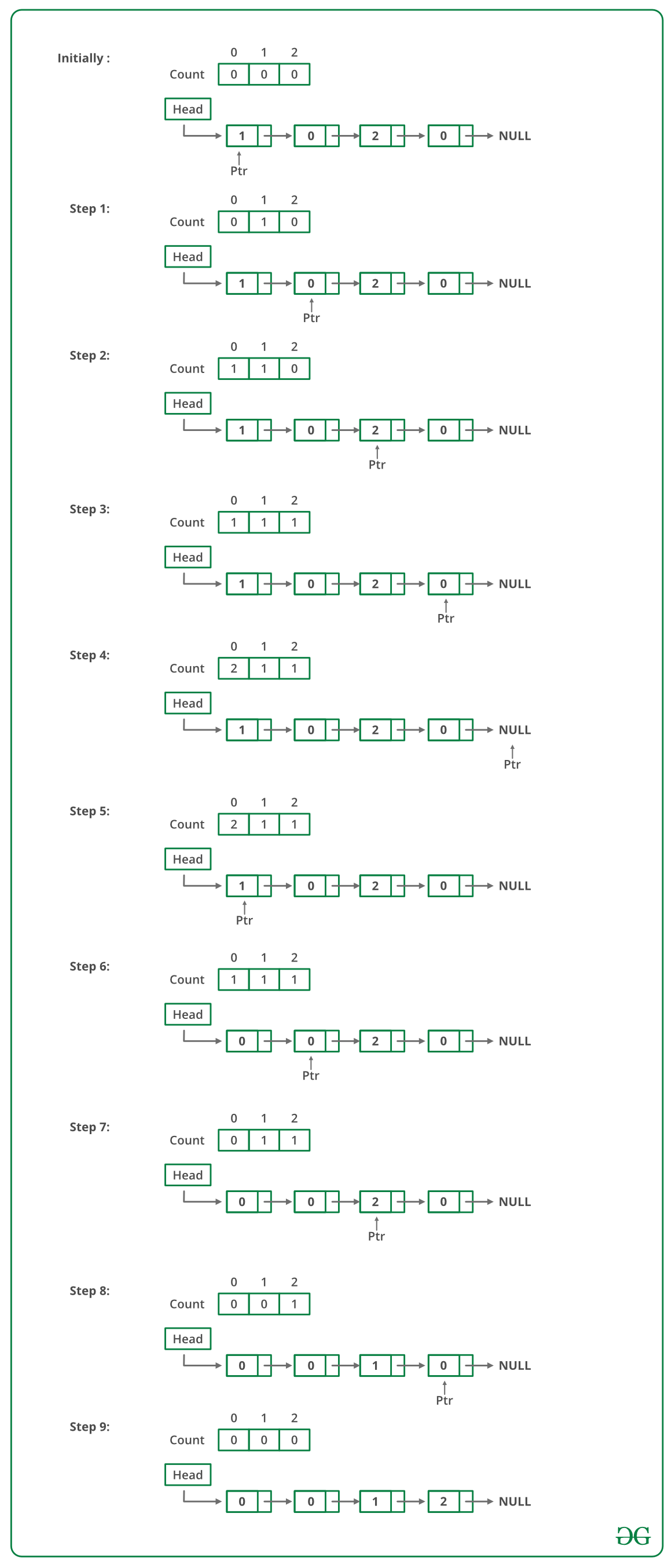C++程序 对0、1、2形式的链表进行排序
给出一个由0、1和2组成的链表,请将其排序。
示例:
输入: 1->1->2->0->2->0->1->NULL
输出: 0->0->1->1->1->2->2->NULL
输入: 1->1->2->1->0->NULL
输出: 0->1->1->1->2->NULL
可以使用以下步骤来对给定的链表进行排序。
- 遍历该列表,并计算0、1和2的数量。让n1、n2和n3分别为计数。
- 再次遍历列表,用0填充前n1个节点,然后用1填充n2个节点,最后用2填充n3个节点。
下面的图形化解释以上过程:

下面是以上方法的实现:
// C++程序,用于对包含0、1或2的链表进行排序
#include <bits/stdc++.h>
using namespace std;
// 链表节点
class Node
{
public:
int data;
Node* next;
};
// 用于对包含0、1和2的链表进行排序的函数
void sortList(Node *head)
{
// 将“0”、“1”和“2”的计数初始化为0
int count[3] = {0, 0, 0};
Node *ptr = head;
/* 计算“0”、“1”和“2”的总数
count[0]将存储“0”的总数
count[1]将存储“1”的总数
count[2]将存储“2”的总数 */
while (ptr != NULL)
{
count[ptr->data] += 1;
ptr = ptr->next;
}
int i = 0;
ptr = head;
/* 假设count[0] = n1,count[1] = n2
和count[2] = n3,
现在从头节点开始遍历列表,
1)用0填充列表,直到n1> 0
2)用1填充列表,直到n2> 0
3)用2填充列表,直到n3> 0 */
while (ptr != NULL)
{
if (count[i] == 0)
++i;
else
{
ptr->data = i;
--count[i];
ptr = ptr->next;
}
}
}
// 用于推入节点的函数
void push (Node** head_ref,
int new_data)
{
// 分配节点
Node* new_node = new Node();
// 将数据放入
new_node->data = new_data;
// 链接新节点的旧列表
new_node->next = (*head_ref);
// 将头指针移动到指向新节点
(*head_ref) = new_node;
}
// 用于打印链表的函数
void printList(Node *node)
{
while (node != NULL)
{
cout << node->data << " ";
node = node->next;
}
cout << endl;
}
// 驱动程序
int main(void)
{
Node *head = NULL;
push(&head, 0);
push(&head, 1);
push(&head, 0);
push(&head, 2);
push(&head, 1);
push(&head, 1);
push(&head, 2);
push(&head, 1);
push(&head, 2);
cout << "在排序之前的链表:";
printList(head);
sortList(head);
cout << "排序之后的链表:";
printList(head);
return 0;
}
输出:
在排序之前的链表:2 1 2 1 1 2 0 1 0
排序之后的链表:0 0 1 1 1 1 2 2 2
时间复杂度: O(n),其中n是链表中节点的数量。
辅助空间: O(1)
 极客教程
极客教程